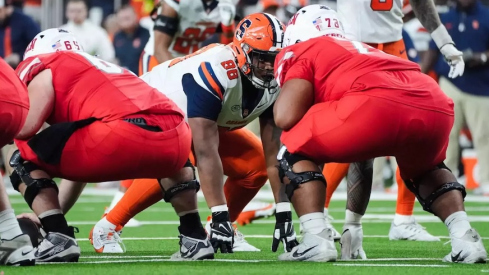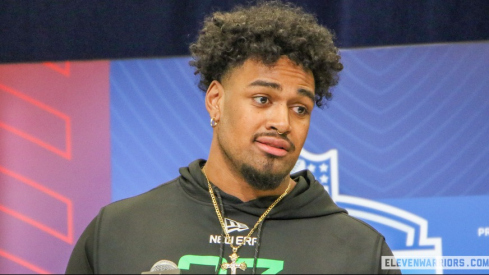
The 2013 season began on a positive note for Michigan* but has since become a nightmare, namely because the Wolverine offense is increasingly dysfunctional. The Wolverine offensive utility is best epitomized by consecutive weeks with negative rushing yards, topped off with a home loss to Nebraska in which Michigan could only manufacture one touchdown, despite recovering a muffed Nebraska punt inside the 30 yard line.
Is it therefore worth examining what has happened with the Michigan offense. Is it the scheme of offensive coordinator Al Borges? Is it the offensive talent level?
As is often the case, the answer is likely both. Scheme and execution are creating a mutually reinforcing negative effect. The lack of talent at particular spots has prevented Borges from running the type of offense he would prefer. Borges' play calling has defaulted to a hodgepodge of pro and spread looks without any coherent whole, allowing defenses to recognize what is coming pre-snap. Unfortunately from Michigan's perspective, this negative cycle is only become worse with each passing week.
What He Wants is not what he's got
Al Borges is not and has never been a spread to run coach. Borges instead moved up the coaching ranks as a West Coast disciple, including stops at UCLA and Auburn. Borges teamed with Brady Hoke at San Diego State to combine a West Coach passing scheme with a power-based run game, the same formula that Hoke wanted Borges to bring to Ann Arbor.
But Hoke and Borges inherited Rich Rodriguez's spread recruits, primarily in the form of Denard Robinson. In Hoke's first season, Borges adapted enough to using Robinson as a runner to lead Michigan to an 11-2 record and a Sugar Bowl victory. Borges received a lot of credit at the time for being flexible, particularly in comparison to Rodriguez's disastrous first year when he tried to insert pro-style quarterbacks into his spread scheme.
In hindsight, however, it may have been Robinson who was papering over deficiencies in talent amongst Michigan's offensive staff and players. Robinson was a gifted and explosive runner, one who was a threat to create explosive plays at any time. Defenses were forced to game plan to stop Robinson, preventing teams from selling out against certain looks.
Now Is the Time (OR MAYBE NOT)
Robinson's departure from Ann Arbor was supposed to allow Borges to fully implement his pro-style offense this season with quarterback Devin Gardner. But that plan quickly fizzled for several reasons.
The first was the inability to run the football from under center. The Wolverines' interior line has been a mix of walk-ons and inexperienced players, and the Michigan coaching staff has spent the season playing musical chairs with the center and guard positions. Michigan has also received mediocre play from the tailback position. Fitzgerald Touissant is steady as a runner, but does not have the ability to make something out of nothing, which has often been the case.
The remaining problem with Wolverine I formation run game is the Michigan passing game. Michigan is not like Stanford where they can line up with multiple tight ends, run the football effectively and then throw play action off those looks. Borges would instead prefer to operate a NFL style passing game. The general reaction from an NFL team that cannot run the football is to repeatedly throw to move the football and try to force defenders out of the tackle box.
But Michigan is unable or unwilling to throw the football with the regularity or consistency necessary to force defenders out of the tackle box. While Gardner has had his moments, he has been turnover prone and shown a tendency to lock onto receivers. This is not uncommon. Staying in the pocket and working through five receiver progressions is extremely difficult. The NFL has trouble finding 32 quarterbacks that can consistently do so. This is why colleges have increasingly gone to spread schemes. While certainly not full proof, an offense can spread out the defense to create structural advantages where the quarterback can make quick throws or run.
Michigan's offensive line and tailbacks have also struggled in pass protection, in particular failing to pick up stunts and blitzes, leading to an avalanche of sacks that has resulted in Gardner being increasingly gun shy in the pocket.
The Total is less than its parts
As a result, Michigan has not been able to run or throw consistently from under center. In an attempt to move the football Borges has turned to doses of spread read plays, in particular inverted veer.
But there are several problems with the mix and match approach of spread and pro styles. One is simply that practice time is limited. Plays can have a multiplying effect if the formation and blocking schemes are the same but the backfield action is different. This provides a different look to the defense but limits the offense from having to learn new concepts. But if a team is mix and matching disparate plays, an offense spends time practicing a bunch of things and not being good at any of them.
The bigger issue is that the disparate plays are not coherent or provide any constraint to the defense. There is no attempt to run a counter if a team is overplaying a base look. Opposing defenses can increasingly identify the type of plays Michigan will run depending on pre-snap formation and alignment. From under center Michigan tends to run lead run plays or max protect play action with two and three man routes. From the shotgun, Michigan is going to pass or run inverted veer. The Michigan offense is the opposite of Homer Smith's stated maxim that
Every primary backfield action needs to threaten all 11 defenders. What a primary play needs is good counter plays. Every defender needs to be worried about the ball coming to his area – on a throwback screen, a reverse, a play-action pass, or whatever – as a play begins.
Worse, Michigan has problems from each look. Michigan is so deficient under center that a defense can load the line of scrimmage. A defense will generally put at least one, if not more, defenders in the box. For instance, Nebraska often played Buddy Ryan's 46 defense when Michigan went under center, where the defensive line shifts weak to a bear front, the linebackers shift strong, and one of the safeties comes down as a linebacker.

Michigan's max protect play action passing only exacerbates the problem, as defenses are giving their linebackers key reads. If the running backs stay in to block the linebackers automatically blitz. This has proved a mismatch against the Wolverine protection schemes. (video H/T: MGoBlog).
Defenses bet that Michigan's receivers either can't get open against cover 1 man or that the pressure will reach Gardner before they do.
Plays Do Not an Offense Make
From the shotgun Michigan has had a different but equally troubling problem. Teams have figured out that Michigan wants Gardner to keep on inverted veer and are attacking the mesh point from the edge. (Video H/T: MGoBlog).
There are a number of ways a spread offense could respond to effectively counter the defense. They can fake the jet sweep with the offensive line blocking inside zone for the quarterback away from the blitz. They can run lead quarterback outside zone to the opposite side. Or they can run play action off inverted veer action.
Michigan's problem is that Borges has done none of this. It is unclear if this is an act of omission and commission. Again, Borges is not a spread coach. He may not have a feel or ability to game plan spread read constraints. Perhaps Michigan is trying to do so many things they do not have sufficient practice time. Or perhaps Borges is simply stubborn. Whatever the case, Michigan had success earlier this year moving the football from the shotgun but that has dissipated as their tendencies have become obvious and Borges has not adjusted.
The upshot is that the Michigan offense has spiraled downhill as defenses gain more film. Gardner's play has also taken a step back as he has received a non-stop pounding. He has developed happy feet in the pocket and has become increasingly hesitant to throw into tight places. There are thus no easy fixes for Michigan as it seeks to pull itself out of its negative trajectory.
* This post is made possible by the excellent analysis of Brian Cook and others at MGoBlog. They have provided far more in-depth analysis of this issue then I ever could. I consider it a must read for Michigan or Ohio State fans.

